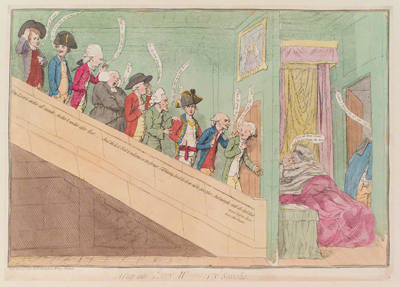A Peep into Lady W!!!!!y's Seraglio
This is the last of several prints Gillray created in response to the infamous trial between Sir Richard Worsley and George Bissett for "Criminal Conversation with [Lady Worsley] the Plaintiff's Wife." In 1782, at a time women were regarded as, in effect, the property of their husbands, a proof of adultery was thought to diminish the value of that "property." Consequently, the injured husband was allowed to sue for recovery of "damages."
Bent on revenge and clearly assuming he had an open and shut case against Bissett and his wife, Sir Richard sought damages to the tune of £20,000, an enormous sum which would spell financial ruin for Bissett and would, he hoped, bring his chastened wife back to her senses. After all, he must have thought, the choice between life with Bissett in debtor's prison and life with him on a rich estate with servants would be obvious. What he had not counted on was the strength of Lady Worsley's attachment to Bissett and her corresponding hatred of himself.
So during the course of the the trial Lady Worsley made no attempt to dispute the charge of adultery with Bissett. Instead, her totally unexpected defense demonstrated that Sir Richard had, in fact, enjoyed prostituting his wife and that he had himself already diminished his wife's "value" long before the appearance of Bissett by both actively and passively encouraging numerous affairs with friends and associates. Indeed, so successful was Lady Worsley in this desperate defense that though the jury nominally found for Sir Richard, it reduced the award of damages from £20,000 to one shilling.

© National Portrait Gallery, London
In one of his most graphic and heartless prints, Gillray picks up upon the rumors circulating at the time of as many as twenty-seven lovers in Lady Worsley's past, portraying her as an insatiable nymphomaniac. He shows her in bed with one lover (clearly assuming the dominant position) while another lover is still pulling up his breeches totally spent from his efforts. Straddling her present bedfellow, Lady Worsley repeats a provocative line from Pope's Eloisa to Abelard: "Give me all thou canst and let me dream the rest. On the bedstand is a copy of Aretino's Postures, the infamous Renaissance book of sexual positions.
Ouside, along the significantly descending stairs to her bedroom, nine more men await their turn to enjoy Lady Worsley's favors. On the balustrade there are lines from Nicholas Rowe's Fair Penitent.
One lover to another still succeeds, Another & another after that. —And the last Fool is welcome as the former: Till having lov'd his hour out he gives place, And mingles with the herd that went before him.
In addition to providing an apt description of the sad situation, the reference to The Fair Penitent reinforces the ironic message provided by the picture of Lucretia above the bedroom door. For unlike Lady Worsley, both Lucretia, the famous Roman matron raped by Tarquin, and Calista, seduced by Lothario, kill themselves rather than live on after their chastity been lost.
The variety of men in line is meant to suggest the indiscriminate nature of Lady Worseley's sexual appetite. They include lords, gentlemen, a soldier, a clergyman, and a country bumpkin. Some of them are likely to be portraits. The man with the quizzing glass, for instance, is almost certainly Lord Cholmondeley, who appeared in an earlier print by Gillray, Regardez moi. Others are likely to include George William Coventry, Viscount Deerhurst, Lieutenant Edward Rushworth, the Honourable Charles Wyndham, and James Graham, Marquess of Graham.
Sources and Reading
- Commentary from the British Museum on A Peep into Lady W!!!!!y's Seraglio
- Hallie Rubenhold, The Lady in Red, 2008
- "Seymour Fleming," Wikipedia
- "Sir Richard Worsley, 7th Baronet," Wikipedia
Comments & Corrections
NOTE: Comments and/or corrections are always appreciated. To make that easier, I have included a form below that you can use. I promise never to share any of the info provided without your express permission.